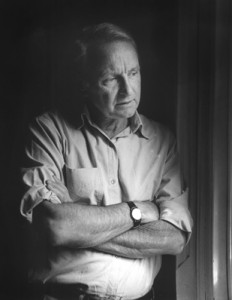Maurice Gee – NOVELIST

Born in Whakatane in 1931, Maurice Gee is one of New Zealand’s best known writers, both for adults and children. He has won many literary awards, including the Wattie Book Award (twice), the Deutz Medal for fiction in the Montana New Zealand Book Awards and the New Zealand Book Award for fiction (four times). He has also won the Children’s Book of the Year Award. In 2003, Gee was among ten of New Zealand’s greatest living artists named as Arts Foundation of New Zealand Icon Artists. In 2004, he received the Prime Minister’s Award for Literary Achievement for Fiction.
Gee was brought up in Henderson, a suburb of Auckland, a location that frequently features in his writing. He completed his BA and MA degrees at the University of Auckland which subsequently recognized him with a Distinguished Alumni Award in 1998 and an honorary Doctor of Literature in 2004.Gee was 16 when he knew he wanted to write, partially inspired by an early love of Charles Dickens. His first short story was published in 1955, when he was 24. His first novel, The Big Season, followed in 1962. Gee began to attract serious attention at home and abroad with his 1979 novel, Plumb, which won Britain’s prestigious James Tait Award for Best Novel (past winners include EM Forster, Graham Greene and Salman Rushdie).Since then, he has won more literary awards than any other New Zealander, most recently being the inaugural Honored New Zealand Writer at the 2012 Auckland Writers Festival, and has had several of his books turned into feature films.Over the years, Gee has collected superlatives the way other people collect stamps. He has been fingered as “our greatest living writer” (writer Paula Morris), “the best prose writer of his generation” (poet Kevin Ireland) and “one of the finest writers in the English-speaking world” (London Sunday Times).According to Gee’s entry in the Oxford Companion to New Zealand Literature: “Each of Gee’s novels bountifully gives us a rich vision of some region and aspect of New Zealand life and human life in general. Each is people with a variety of intensely living and unique personalities together with lush images of the natural and social worlds.”
THE FAT MANFirst published in 1995 by Viking, Auckland, and subsequently Puffin in 2000. Despite the controversy surrounding The Fat Man, the novel found great popularity with readers of all ages, including those in other countries.Awards include:Winner Aim Junior Fiction AwardWinner, The Esther Glen Award, 1995 (the longest running and most renowned literary prize for New Zealand children’s literature)Winner Aim Children’s Book of the YearUS Publisher’s Weekly Top 10 Children’s Books of the Year 1997
HIS WORK
Novels
- The Big Season. London: Hutchinson, 1962. London: Arrow, 1964. Wellington: Allen & Unwin, 1985.[6]
- A Special Flower. London: Hutchinson, 1965.
- In My Father’s Den. London: Faber, 1972. Auckland: Oxford UP, 1978.
- A Glorious Morning, Comrade. Auckland: Auckland UP and Oxford UP, 1975.
- Games of Choice. London: Faber, 1976. Auckland: Oxford UP, 1978.
- Under the Mountain. Wellington: Oxford UP, 1979.[6]
- The World Around the Corner. Wellington: Oxford UP, 1980.
- Plumb. London: Faber, 1981.[6]
- Meg. London: Faber, 1981. New York: St. Martin’s Press, 1982. Auckland: Penguin.[6]
- The Halfmen of O. Auckland: Oxford UP, 1982. Harmondsworth: Puffin, 1986.
- Sole Survivor. London: Faber, 1983. New York: St. Martin’s Press, 1983. Auckland: Penguin, 1983.[6]
- The Priests of Ferris. Auckland: Oxford UP, 1984.
- Motherstone. Auckland: Oxford UP, 1985.
- The Fire-Raiser. Auckland: Puffin, 1986.
- Collected Stories. Auckland: Penguin, 1986. New York: Penguin, 1987.
- Prowlers. London and Boston: Faber, 1987.
- The Champion. Auckland : Puffin, 1989; New York: Simon & Schuster, 1993.
- The Burning Boy. London : Faber, 1990, 1992; Auckland : Viking, 1990.
- Going West. Auckland : Viking, 1992; London: Faber, 1992; Auckland: Penguin, 2000.
- Crime Story.Auckland : Penguin Books, 1994; Auckland: Viking, 1994; London: Faber, 1995.
- The Fat Man. Auckland : Viking, 1995; Auckland: Puffin, 2000.
- Plumb Trilogy. Auckland: Penguin, 1995.
- Loving Ways. Auckland : Penguin, 1996.
- Live Bodies. Auckland : Penguin, 1998; London: Faber, 1998; Scheuring: Black Ink, 2002 (German edition).
- Orchard Street. Auckland : Viking, 1998.
- Hostel Girl. Auckland : Puffin, 1999.
- Ellie and the Shadow Man. Auckland: Penguin, 2001.
- The Scournful Moon. Auckland: Penguin, 2003.
- Blindsight. Auckland: Penguin, 2005
- Salt. Auckland: Puffin, 2007
- Gool. Auckland: Puffin, 2008
- Access Road. Auckland: Penguin, 2009
- The Limping Man. Auckland: Puffin, 2010
Short Stories: First Publication
- In at the Death. Kiwi (1955): 21-26.
- The Widow. Landfall 9 (1955): 196-213. In GMC, CS.[6]
- Evening at Home. Arena 45 (1956): 23-24.
- The Quarry. Arena 46 (1957): 6-10, 13.
- A Sleeping Face. Landfall 11 (1957): 194-221. In GMC, CS.
- A Girl in Blue. Mate 2 (1958): 10-19.
- While the Flag was Up. Arena 50 (1958–59): 13-17, 28.
- The Losers. Landfall 13 (1959): 120-47. In Landfall Country: Work from Landfall, 1947-1961. Christchurch: Caxton Press, 1962, 24-56. In New Zealand Short Stories, Second Series. Ed. C.K. Stead. London: Oxford UP, 1966, 255-95. In GMC, CS.
- Facade. Mate. 4 (1960): 26-33.
- Schooldays. Mate. December 1960: 2-11. In GMC, CS.
- The Champion. Landfall 20 (1966): 113-25. In GMC, CS.
- Down in the World. Landfall 21 (1967): 296-302. In GMC, CS.
- A Retired Life. Landfall 23 (1969): 101-16. In GMC, CS.
Adaptations
- 1982 New Zealand TV series titled Under the Mountain[7]
- 2004 Movie, Fracture. Directed by Larry Parr. Based on Crime Story[8]
- 2004 Movie, In My Father’s Den. Directed by Brad McGann[9]
- 2009 Movie starring Sam Neill of Under the Mountain [10]
- tbc Movie in development by Weta Workshop of The Halfmen of O.[11